Performance Evaluation and Simulation Optimization of Outdoor Environmental Space in Communities Based on Subjective Comfort: A Case Study of Minhe Community in Qian’an City
Abstract
1. Introduction
2. Materials and Methods
2.1. Research Area
2.2. Data Sources
2.3. Research Methods
2.3.1. Multidimensional Theoretical Analysis
2.3.2. Comprehensive Evaluation Method Combining Analytic Hierarchy Process (AHP) and Delphi Method
2.3.3. Software Simulation Method
3. Evaluation System Construction
3.1. Principles of Construction
3.1.1. Principle of Comprehensiveness
3.1.2. Principle of Scientific Validity
3.1.3. Principle of Operability
3.1.4. Principle of Simplicity
3.1.5. Principle of Universality
3.2. Construction of the Indicator System
3.3. Evaluation Criteria
4. Results
4.1. Comprehensive Evaluation Results
4.2. Specialized Evaluation Results
4.2.1. Uneven Wind Speed and Lack of Vegetation Coverage
4.2.2. Low Outdoor Shading Rate and Heat-Absorbing Paving
4.2.3. Uneven Night Lighting and Low Light Utilization
4.2.4. Poor Sanitation Conditions and Limited Waste Collection Methods
4.2.5. Weak Green Infrastructure and Fragmented Landscape Layers
4.2.6. High Noise Levels and Lack of Natural Sounds
4.2.7. Poor Service Facilities and Low Level of Digitalization
5. Discussion
5.1. Optimization Strategies
5.1.1. Wind Environment Optimization
5.1.2. Environmental Improvements
5.1.3. Sound and Light Environment Optimization
5.1.4. Smart Management
5.2. Simulation Verification
5.3. Applicability Analysis
5.4. Shortcomings
6. Conclusions
Author Contributions
Funding
Data Availability Statement
Acknowledgments
Conflicts of Interest
References
- Marx, K.H.; Engels, F. Die Deutsche Ideologie; People’s Publishing House: Beijing, China, 1960. [Google Scholar]
- Gu, T.; Li, D.; Zhu, S.; Wang, Y. Does sponge-style old community renewal lead to a satisfying life for residents? An investigation in Zhenjiang, China. Habitat Int. 2019, 90, 102004. [Google Scholar] [CrossRef]
- Peiffer-Smadja, O.; Torre, A. Retail decentralization and land use regulation policies in suburban and rural communities: The case of the Île-de-France region. Habitat Int. 2018, 72, 27–38. [Google Scholar] [CrossRef]
- Zhou, D.; Feng, D.; Feng, Z.; Liu, Y.; Xiao, S.L.; He, R.Z. Research progress of living environment comfort. Environ. Ecol. 2023, 8, 65–74+94. [Google Scholar]
- Mohammadzadeh, N.; Karimi, A.; Brown, R.D. The influence of outdoor thermal comfort on acoustic comfort of urban parks based on plant communities. Build. Environ. 2023, 228, 109884. [Google Scholar] [CrossRef]
- Cureau, R.J.; Pigliautile, I.; Pisello, A.L. A new wearable system for sensing outdoor environmental conditions for monitoring hyper-microclimate. Sensors 2022, 22, 502. [Google Scholar] [CrossRef] [PubMed]
- Liu, Y.X.; Feng, L.; Tian, H.; Yang, S.Q. Analysis of the spatial and temporal distribution characteristics of climate comfort in China. J. Geo-Inf. Sci. 2020, 22, 2338–2347. [Google Scholar]
- Tsai, K.T.; Lin, Y.H. Identification of urban park activity intensity at different thermal environments and visible sky by using sound levels. Int. J. Biometeorol. 2018, 62, 1987–1994. [Google Scholar] [CrossRef]
- Yan, C.Q.; Ma, Q.; Wang, M.H. Review of research in urban communities—Empirical research based on WHO recommended guidelines. Archit. J. 2023, 1, 6–13. [Google Scholar]
- Miller, D. The Comfort of Things; Polity: London, UK, 2008. [Google Scholar]
- Hu, X.; Li, B.F.; Chen, H. Review and evaluation framework of outdoor thermal comfort study. Build. Sci. 2020, 36, 53–61. [Google Scholar]
- Rocha, C.A.; Sousa, F.W.; Zanella, M.E.; Oliveira, A.G.; Nascimento, R.F.; Souza, O.V.; Cavalcante, R.M. Environmental quality assessment in areas used for physical activity and recreation in a city affected by intense urban expansion (Fortaleza-CE, Brazil): Implications for public health policy. Expo. Health 2017, 9, 169–182. [Google Scholar] [CrossRef]
- Sen, J.; Nag, P.K. Human susceptibility to outdoor hot environment. Sci. Total Environ. 2019, 649, 866–875. [Google Scholar] [CrossRef] [PubMed]
- Edwards, M.; Johns, D.G.; Leterme, S.C.; Svendsen, E.; Richardson, A.J. Regional climate change and harmful algal blooms in the northeast Atlantic. Limnol. Oceanogr. 2006, 51, 820–829. [Google Scholar] [CrossRef]
- Cao, Y.; Sun, Y.L.; Wu, M.X. Building Science. Acta Ecol. Sin. 2019, 39, 7567–7582. [Google Scholar]
- Takebayashi, H. Effects of air temperature, humidity, and wind velocity distribution on indoor cooling load and outdoor human thermal environment at urban scale. Energy Build. 2022, 257, 111792. [Google Scholar] [CrossRef]
- Wang, G.X.; Qian, L.; Chen, T.; Yang, X.N.; Xu, Z.X.; Zhu, W.P. Take the West Lake in Hangzhou as an example. Acta Ecol. Sin. 2015, 35, 2206–2216. [Google Scholar]
- Luo, Y.L.; Lv, S.; Yin, J.; Jia, Z.W.; Xu, W.G. Improvement method of outdoor microenvironment comfort based on responsive variable space. Archit. J. 2024, 2, 22–28. [Google Scholar]
- Zhang, Y.Y.; Xu, J.J. Simulation Study on Outdoor Thermal Environment and Comfort in Urban Residential Area. Energy Conserv. 2019, 38, 40–43. [Google Scholar]
- Zhang, Z.C.; Yang, D.; Lin, X.; Jia, Y.P. Simulation and evaluation of outdoor wind environment in a residential area in Qingdao city. City House 2021, 28, 89–92. [Google Scholar]
- Jiang, C.H.; Jia, F.Y.; Tang, W.; Wang, C.; Wang, X.Z. Simulation analysis of outdoor wind environment in a residential community in Guilin. Energy Conserv. 2020, 39, 30–33. [Google Scholar]
- Lan, H.F.; Cheng, B. Numerical simulation analysis of outdoor thermal environment improvement strategy of urban high-density communities in Mianyang. Green Build. 2020, 12, 48–51+54. [Google Scholar]
- Al-Atrash, F.Z.; Al-Ayyoub, A. Evaluating urban outdoor thermal comfort in Jabal Al Natheef Amman. Sustainability 2023, 15, 4092. [Google Scholar] [CrossRef]
- Peng, C.; Elwan, A. An outdoor-indoor coupled simulation framework for Climate Change–conscious Urban Neighborhood Design. Simulation 2014, 90, 874–891. [Google Scholar] [CrossRef]
- Lai, P.Y.; Koh, W.S.; Gopalan, H.; Liu, H.; Leong, D.; Tan, J. Outdoor environmental comfort evaluation for retail planning in a tropical business district using Integrated Environmental Modeller. PLoS ONE 2023, 18, e0282106. [Google Scholar] [CrossRef] [PubMed]
- Guo, L.L.; Tang, X.M. Research on walking comfort of community roads under the background of urban double repair—Take Caoyang New Village in Shanghai as an example. Chin. Landsc. Archit. 2020, 36, 70–75. [Google Scholar]
- Xue, S.H.; Ma, Y.; Wang, H. Analysis of multi-way regulation of outdoor comfort in cold areas—Take Zhengzhou as an example. J. Nanjing For. Univ. (Nat. Sci. Ed.) 2022, 46, 210–218. [Google Scholar]
- Yan, Y.C.; Yue, S.P.; Liu, X.H.; Wang, D.; Chen, H. Research progress in climate comfort evaluation at home and abroad. Adv. Earth Sci. 2013, 28, 1119–1125. [Google Scholar]
- Olgyay, V. Design with climate: Bioclimatic approach to architectural regionalism. J. Archit. Educ. 2015, 18, 157–166. [Google Scholar]
- GB/T50378-2019; Assessment Standard for Green Building. China Building Industry Press: Beijing, China, 2019.
- Gagge, A.P.; Fobelets, A.; Berglund, L.A. Standard predictive index of human response to the thermal environment. ASHRAE Transactions. 1986, 2, 709–731. [Google Scholar]
- GB/T 27963—2011; Climatic Suitability Evaluating on Human Settlement. Standards Press of China: Beijing, China, 2011.
- GB50180-2018; Urban Residential District Design Standard. China Building Industry Press: Beijing, China, 2018.
- GB/T 43992-2024; Specification for Construction Service Quality Evaluation of Urban Luminous Environment. Standards Press of China: Beijing, China, 2024.
- Housing Industrialization Promotion Center of the Ministry of Construction. Guidelines for Environmental Landscape Design in Residential Areas; China Building Industry Press: Beijing, China, 2009. [Google Scholar]
- HJ633—2012; Technical Regulation on Ambient Air Quality Index (on Trial). China Environmental Science Press: Beijing, China, 2012.
- GB3838-2002; Environmental Quality Standards for Surface Water. China Environmental Science Press: Beijing, China, 2002.
- GB3096-2008; Environmental Quality Standards for Noise. China Environmental Science Press: Beijing, China, 2008.
- Zhu, Y.M.; Tan, Y.; Ma, Z.L.; Liu, J. Establishment of the thermal comfort model of the outdoor environment. Build. Sci. 2007, 6, 1–3. [Google Scholar]
- Liao, Z.Q.; Xun, R.H.; Pei, X.Z.; Liu, G.B. Building Science. Low Temp. Archit. Technol. 2013, 7, 40–42. [Google Scholar]
- Gao, Y.F.; Yu, J.N.; Liu, L.; Chen, G.; Lin, G.G.; Chen, S.Q. Study on winter heat and comfort of campus public space in hot and humid areas. J. Guangdong Univ. Technol. 2021, 1, 39–45. [Google Scholar]
- Shi, Y.; Ren, C.; Wu, E.R. Improvement strategy of urban design based on outdoor wind environment and thermal comfort—Take Xidan Commercial Street in Beijing as an example. Urban Plan. Forum 2012, 5, 92–98. [Google Scholar]
- Du, T. Research on Environmental Comfort Measure and Environmental Protection Countermeasures in Beijing. Master’s Thesis, Beijing Forestry University, Beijing, China, 2006. [Google Scholar]
- Zhang, K.L.; Wu, T. Take the environmental transformation of Haikou Binhai New Village as an example. Archit. Cult. 2015, 7, 122–124. [Google Scholar]
- Xing, Y.M. Research on Outdoor Thermal Environment Evaluation and Reconstruction Strategy of Old Communities in Mild Areas. Master’s Thesis, Guizhou University, Guizhou, China, 2023. [Google Scholar]
- Lu, M.J. Discussion on the outdoor sound environment in the high-end residential community. Henan Build. Mater. 2008, 1, 22–23. [Google Scholar]
- Hu, X.Q.; Zhang, L.; Li, S.; Zhang, F.F. The fuzzy comprehensive evaluation method for the comfort level of residential light environment. J. Chongqing Univ. Technol. (Nat. Sci.) 2023, 27, 103–107. [Google Scholar]
- Sun, B.D.; Zahng, L.; Xun, A.; Pei, Y.; Ren, P.P.; Liu, S.Z. Comfort analysis of NADPI mathematical model for outdoor wind-heat environment. J. Yantai Univ. (Nat. Sci. Eng. Ed.) 2023, 36, 222–230. [Google Scholar]


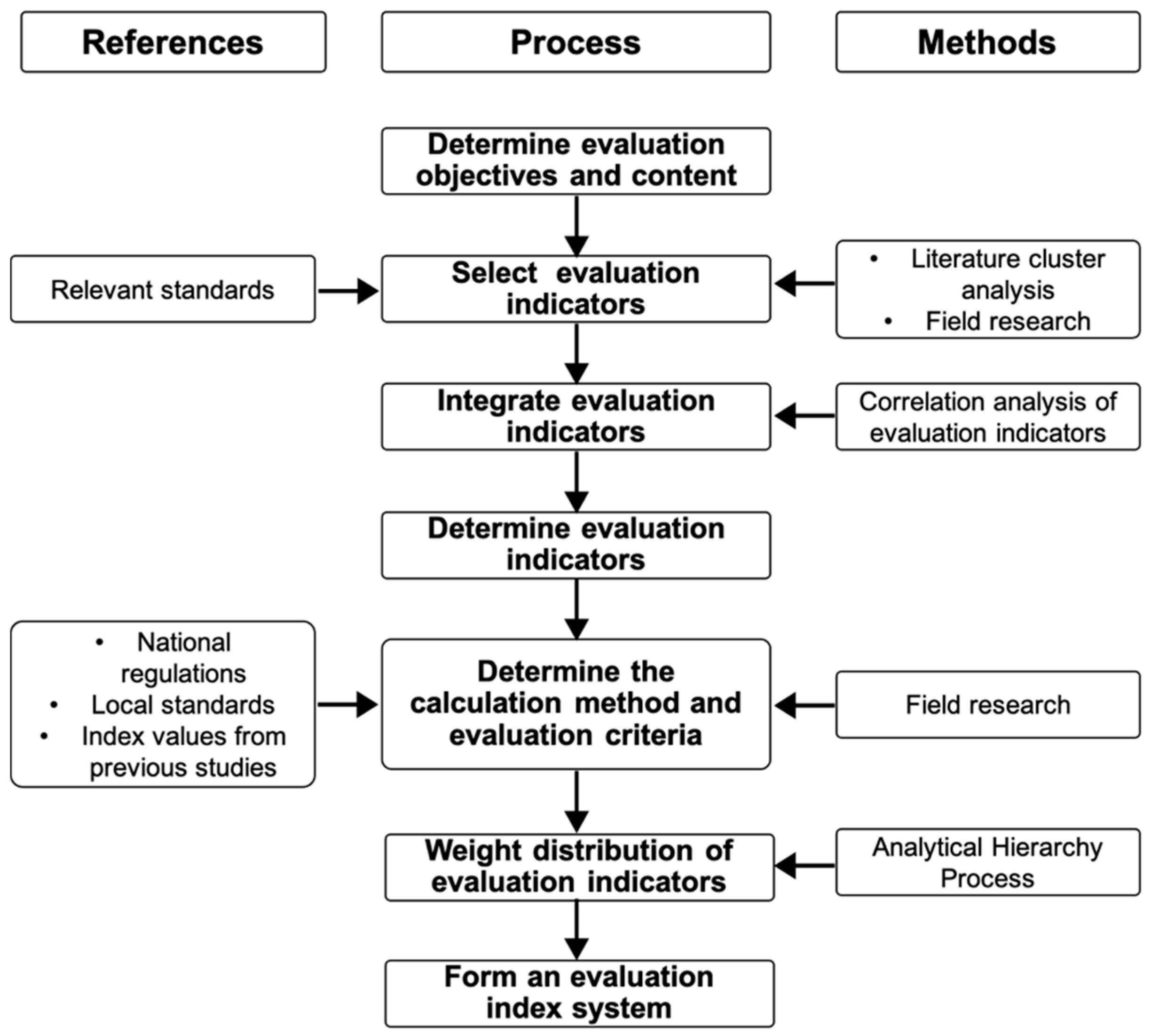
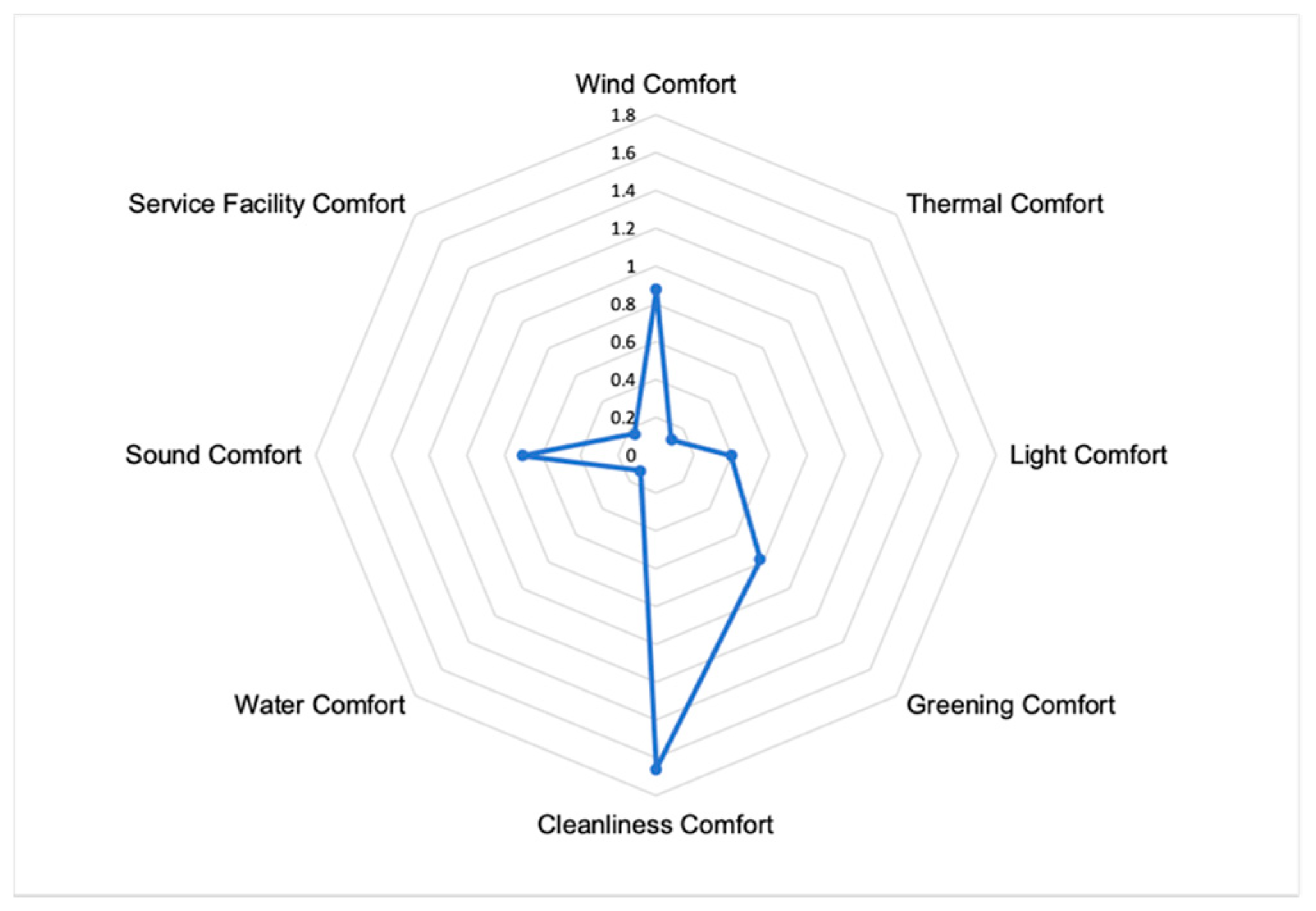

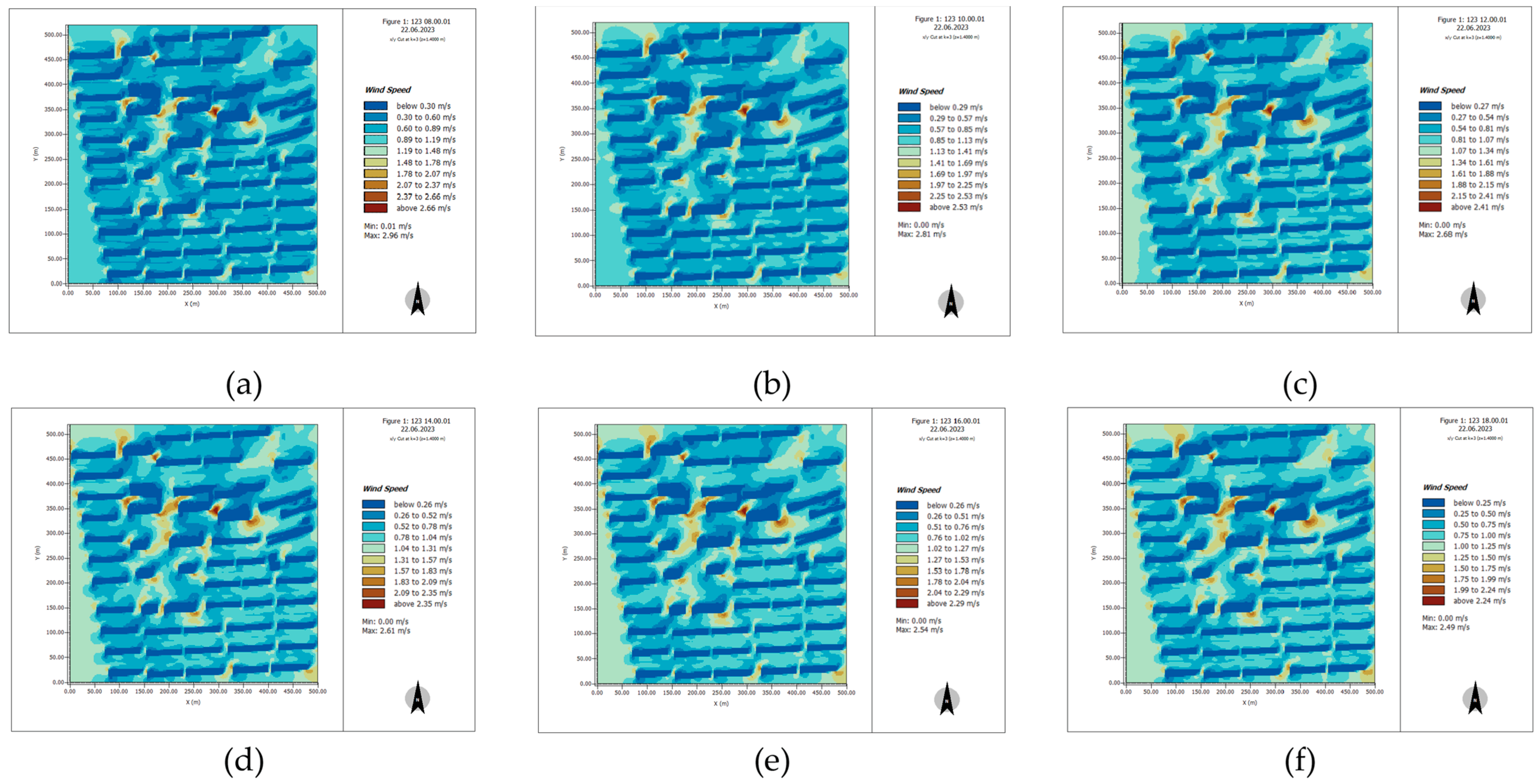

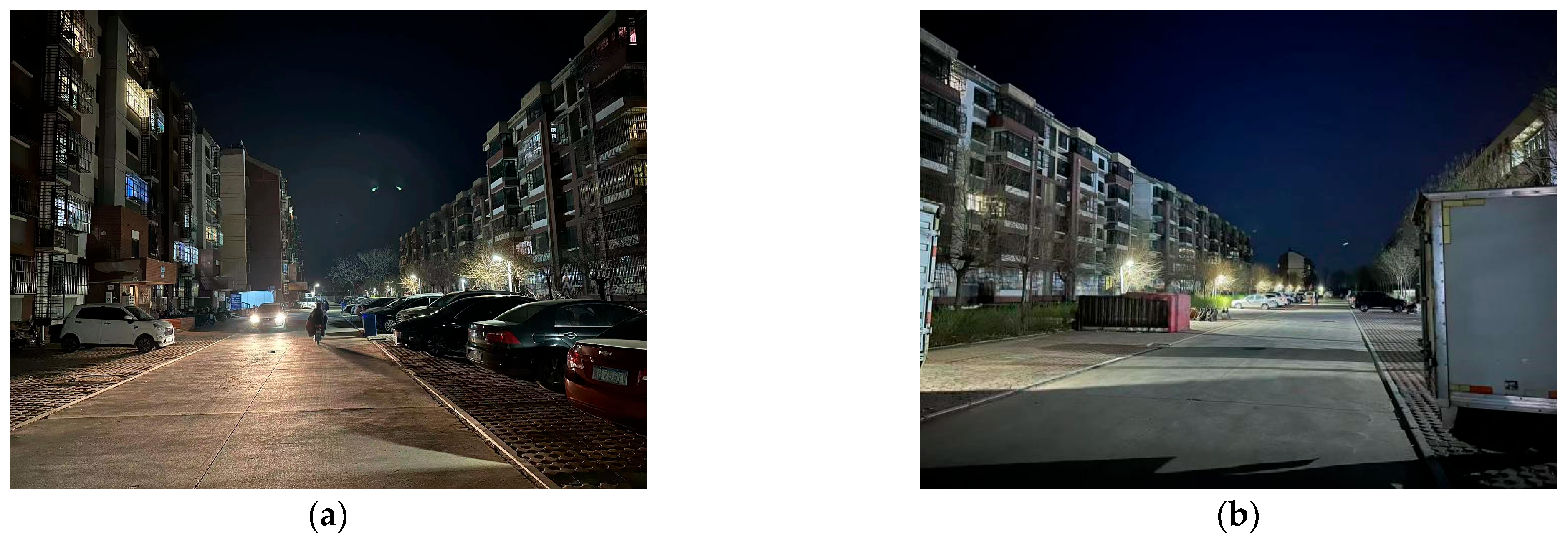
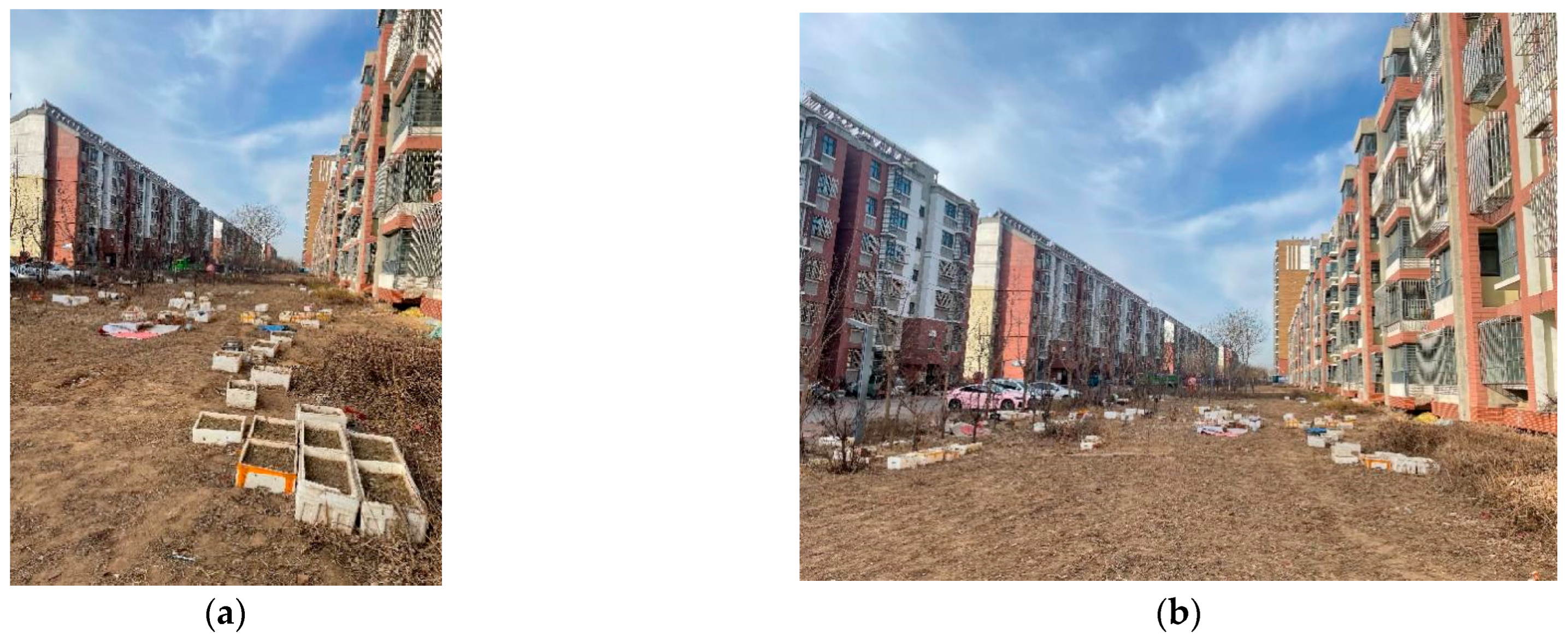

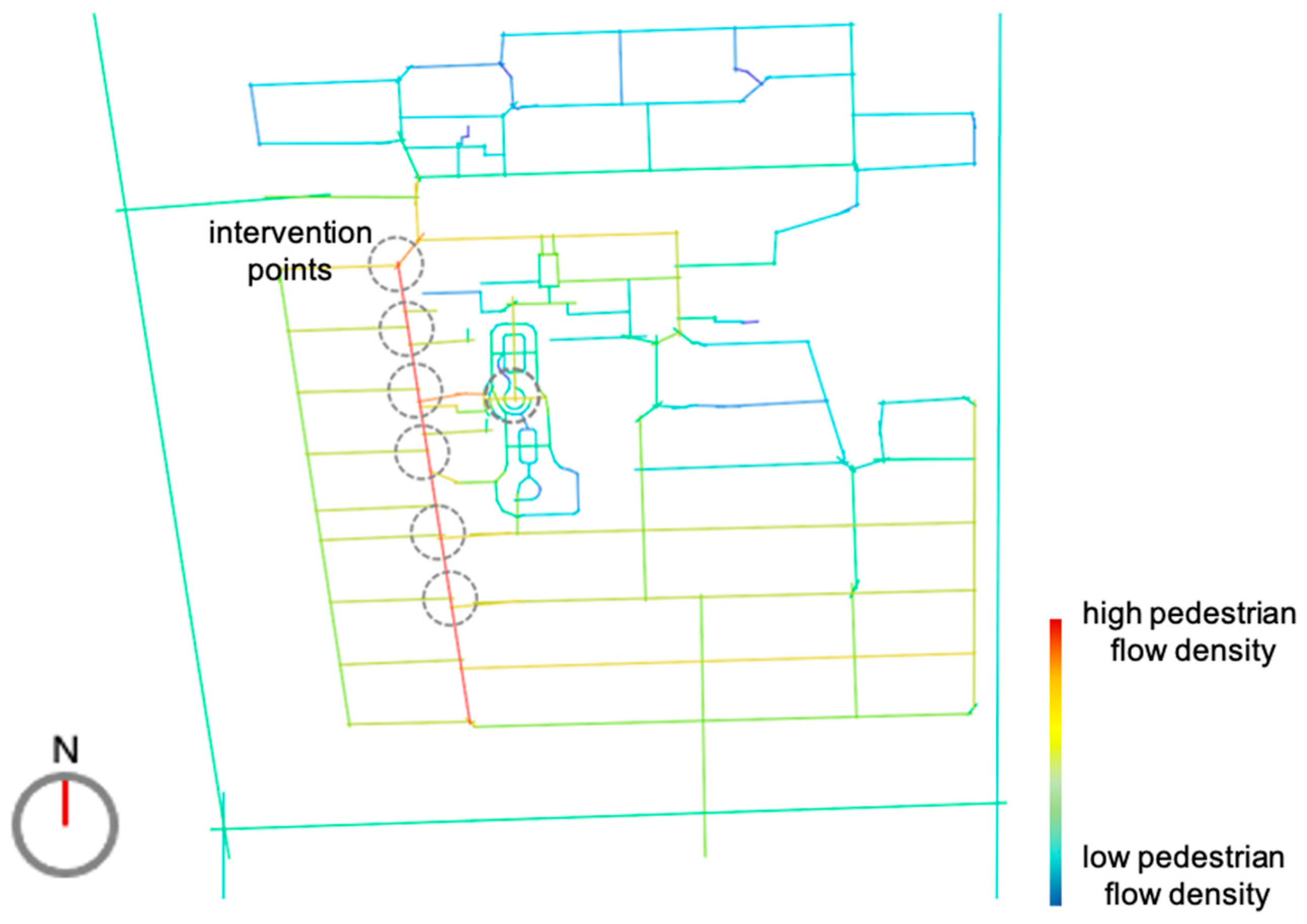
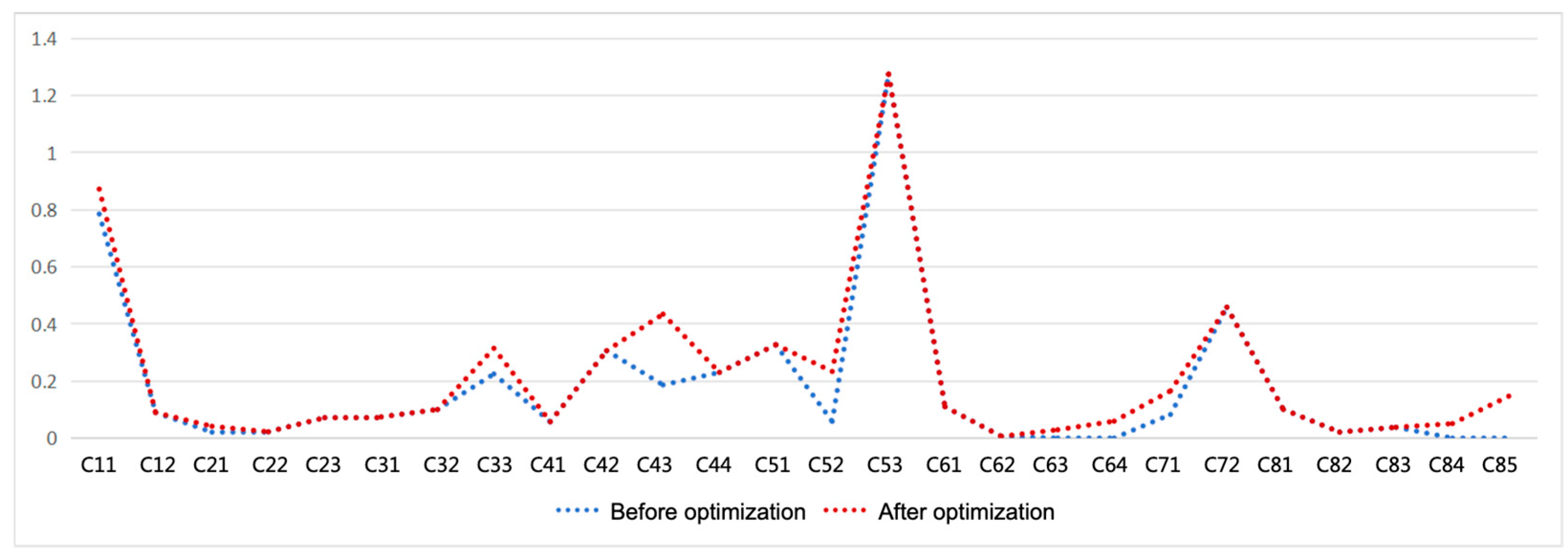
| Category | Subcategory | Specific Type | Factors and Correlation Ranking |
|---|---|---|---|
| Community Outdoor Environmental Comfort | Environmental Indicators | Wind Comfort | Wind Speed, Wind Pressure, Wind Direction |
| Thermal Comfort | Outdoor Shading, Temperature, Humidity, Solar Radiation, Surface Temperature, Solar Energy | ||
| Light Comfort | Natural Day-Night Lighting, UV Intensity, Hours of Sunshine, Light, Daylight Design, Quality of Electric Lighting, Dark Sky, and Light Pollution | ||
| Greening Comfort | Vegetation Coverage, Green Space Ratio, Landscape Plants, Trees, Public Green Space Facilities, Canopy Coverage, Negative Oxygen Ion Concentration, Plant Communities | ||
| Cleanliness Comfort | Air Quality, Air Cleanliness, CO2, CO, Air Monitoring Facilities, Sky Impact Factor, Sky View Factor | ||
| Food Accessibility, Nutrition Education, Dining Areas | |||
| Environmental Hygiene, Pollution Cleanup, Waste Collection, Odor Control | |||
| Bacteria, Fine Particles | |||
| Water Comfort | Water Quality, Drainage Facilities, Water Features, Green Stormwater Infrastructure, Drinking Water Facilities | ||
| Sound Comfort | Noise Levels, Natural Sounds, Wall Sound Insulation, Audio Equipment, Sound Pressure | ||
| Material Indicators | Material Comfort | Material Types, VOC Limits, Use of Green and Non-toxic Materials | |
| Mental Health Indicators | Psychological Comfort | Mental Health Services, Education, Connection with Nature | |
| Infrastructure Indicators | Public Service Comfort | Road Facility Maintenance Frequency, Recreation Square Area, Healthcare Services, Elderly Care Services, Sports Facilities, Physical Activity Opportunities, Activity Spaces, Self-monitoring, Smart Operations |
| Overall Goal | Criterion Level | Indicator Level | Factor Description | Weight |
|---|---|---|---|---|
| Improvement of Outdoor Environmental Comfort (A) | Wind Comfort (B1) | Wind Speed (C11) | Indicates the speed of air movement within the community. | 0.0872 |
| Wind Pressure (C12) | Refers to the pressure exerted by wind within the community area. | 0.0223 | ||
| Thermal Comfort (B2) | Temperature (C21) | Represents the thermal sensation of the community’s temperature. | 0.0103 | |
| Humidity (C22) | Reflects the residents’ perceived comfort based on humidity levels. | 0.0110 | ||
| Outdoor Shading (C23) | Indicates shading facilities in public and activity spaces within the community. | 0.0238 | ||
| Light Comfort (B3) | Hours of Sunshine (C31) | Refers to the cumulative sunlight hours on the winter solstice or coldest day. | 0.0185 | |
| UV Intensity (C32) | Represents the intensity of solar radiation. | 0.0200 | ||
| Night Lighting (C33) | Reflects the quality of lighting conditions provided at night within the community. | 0.0449 | ||
| Greening Comfort (B4) | Green Space Ratio (C41) | The proportion of the vertical projection area of green plants to the total land area. | 0.0190 | |
| Public Green Space (C42) | Open green spaces accessible to residents. | 0.0510 | ||
| Garden Plants (C43) | Various plants used for landscaping and beautification within the community. | 0.0620 | ||
| Negative Oxygen Ion Concentration (C44) | The concentration of negative oxygen ions per unit volume of air. | 0.0460 | ||
| Cleanliness Comfort (B5) | Air Quality (C51) | Concentration levels of pollutants and harmful substances in the air. | 0.0467 | |
| Environmental Hygiene (C52) | Overall cleanliness of the environment. | 0.0583 | ||
| Pollutant Collection (C53) | Radius of garbage bins within the community. | 0.1416 | ||
| Water Comfort (B6) | Water Quality (C61) | The quality and characteristics of water bodies within the community. | 0.0137 | |
| Drainage Facilities (C62) | Infrastructure for rainwater, wastewater, and sewage management. | 0.0060 | ||
| Landscape Water Bodies (C63) | Water bodies designed for the beautification of the community. | 0.0145 | ||
| Green Stormwater Infrastructure (C64) | Proportion of green infrastructure for stormwater control within green spaces. | 0.0197 | ||
| Sound Comfort (B7) | Noise Levels (C71) | Existing noise levels within the community (measured in dB). | 0.0413 | |
| Natural Sounds (C72) | Sounds from nature, such as birdsong, rustling leaves, and flowing water. | 0.1146 | ||
| Service Facility Comfort (B8) | Road Maintenance Frequency (C81) | Frequency of road maintenance and repairs within the community. | 0.0201 | |
| Recreation Square Area (C82) | Public spaces for leisure, entertainment, and relaxation. | 0.0208 | ||
| Healthcare Services (C83) | Medical and health promotion services available within the community. | 0.0126 | ||
| Elderly Care Services (C84) | Activities and institutions providing care for the elderly within the community. | 0.0253 | ||
| Smart Operations (C85) | Intelligent management of infrastructure, services, and resources using advanced IT and IoT. | 0.0489 |
| Evaluation Level | I (Excellent) | II (Good) | III (Average) | IV (Below Average) | V (Poor) | Reference Standard |
|---|---|---|---|---|---|---|
| Evaluation Index | {8,10} | {6,8} | {4,6} | {2,4} | {0,2} | |
| Wind Speed | <2 m/s | <5 m/s | <8 m/s | <11 m/s | >15 m/s | GB/T 50378-2019 “Assessment Standard for Green Building” [30] |
| Wind Pressure | No vortices, calm | No vortices, slight breeze | Small vortices, slight breeze | Many vortices, fast wind | Many vortices, high wind speed | GB/T 50378-2019 “Assessment Standard for Green Building” [30] |
| Temperature | ±24 °C | 20–24 °C, 24–28 °C | 16–20 °C, 28–32 °C | 10–16 °C, 32–35 °C | <10 °C, >35 °C | Gagge’s Effective Temperature Standard [31] |
| Humidity | <24% | <20% | <17% | <14% | <14%, >27.5% | GB/T 27963-2011 “Climatic suitability evaluating on human settlement” [32] |
| Shading | >35% | 30–35% | 25–30% | 20–25% | <20% | GB/T 50378-2019 “Assessment Standard for Green Building” [30] |
| Sunlight Hours | >3 h | 2.5–3 h | 2–2.5 h | 1.5–2 h | <1.5 h | GB50180-2018 “Urban Residential District Design Standard” [33] |
| UV Index | <2 | 2–4 | 4–6 | 6–9 | >10 | GB/T 27963-2011 “Climatic suitability evaluating on human settlement” [32] |
| Night Lighting | 7–8 | 8–9 | 9–10 | 10–11 | >11 | GB/T 43992-2024 “Specification for construction service quality evaluation of urban luminous environment” [34] |
| Green Space Ratio | >35% | 30–35% | 28–30% | 25–28% | <25% | GB50180-2018 “Urban Residential District Design Standard” [33] |
| Public Green Space | >500 m2 | 480–500 m2 | 450–480 m2 | 400–450 m2 | <400 m2 | Guidelines for Environmental Landscape Design in Residential Areas [35] |
| Garden Plant Layers | 5 layers | 4 layers | 3 layers | 2 layers | 1 layer | Guidelines for Environmental Landscape Design in Residential Areas [35] |
| Negative Oxygen Ion Concentration | ≥1200 ions/cm3 | 1000–1200 ions/cm3 | 500–1000 ions/cm3 | ≥500 ions/cm3 | ≤500 ions/cm3 | GB/T 27963-2011 “Climatic suitability evaluating on human settlement” [32] |
| Air Quality Index (AQI) | 0–50 | 51–100 | 101–150 | 151–200 | >200 | HJ633—2012 “Technical Regulation on Ambient Air Quality Index (on trial)” [36] |
| Litter (pieces/1000 m2) | ≤4 | 4–6 | 6–8 | 8–10 | ≥10 | Subjective Evaluation |
| Garbage Bin Radius | 50 m | 50–60 m | 60–70 m | 70–80 m | ≥80 m | Subjective Evaluation |
| Water Quality Category | I–II | III | IV | V | Below V | GB3838-2002 “Environmental quality standards for surface water” [37] |
| Drainage Network Density | 1.77 km/km2 | 1.21–1.77 km/km2 | 0.869–1.21 km/km2 | 0.332–0.869 km/km2 | ≤0.332 km/km2 | GB/T 27963-2011 “Climatic suitability evaluating on human settlement” [32] |
| Landscape Water Bodies | 6 types | 5 types | 4 types | 3 types | ≤2 types | Guidelines for Environmental Landscape Design in Residential Areas [35] |
| Green Stormwater Infrastructure | ≥50% | 40–50% | 30–40% | 20–30% | ≤10% | GB/T 50378-2019 “Assessment Standard for Green Building” [30] |
| Noise Levels (dB) | ≤60 | 60–65 | 65–70 | 70–75 | ≥75 | GB 3096-2008 “Environmental quality standards for noise” [38] |
| Natural Sounds | Water, vendors’ calls | Wind, rustling leaves | Laughter, conversation | Vendors’ calls | Traffic, construction sounds | Subjective Evaluation |
| Road Maintenance Frequency | Daily | Weekly | Monthly | Quarterly | Annually | Subjective Evaluation |
| Recreation Square Area | 800 m2 | 750 m2 | 700 m2 | 600 m2 | 500 m2 | Subjective Evaluation |
| Healthcare Services | 5 levels | 4 levels | 3 levels | 2 levels | ≤1 level | GB50180-2018 “Urban Residential District Design Standard” [33] |
| Elderly Care Center Area | 750 m2 | 650–750 m2 | 550–650 m2 | 450–550 m2 | ≤350 m2 | GB50180-2018 “Urban Residential District Design Standard” [33] |
| Smart Operations | >4 systems | 3–4 systems | 2–3 systems | 1–2 systems | <1 system | GB/T 50378-2019 “Assessment Standard for Green Building” [30] |
| Goal Level A | Criterion Level B | Criterion Weight | Weighted Score | Indicator Level | Expert Weighted Score | Baseline Score | Weighted Score |
|---|---|---|---|---|---|---|---|
| A: Outdoor Environmental Comfort Improvement | B1: Wind Comfort | 0.1095 | 0.874 | C11: Wind Speed | 0.0872 | 9 | 0.7848 |
| C12: Wind Pressure | 0.0223 | 4 | 0.0892 | ||||
| B2: Thermal Comfort | 0.0451 | 0.114 | C21: Temperature | 0.0103 | 2 | 0.0206 | |
| C22: Humidity | 0.0110 | 2 | 0.022 | ||||
| C23: Outdoor Shading | 0.0238 | 3 | 0.0714 | ||||
| B3: Light Comfort | 0.0834 | 0.3985 | C31: Hours of Sunshine | 0.0185 | 2 | 0.074 | |
| C32: UV Intensity | 0.0200 | 7 | 0.1 | ||||
| C33: Night Lighting | 0.0449 | 5 | 0.2245 | ||||
| B4: Greening Comfort | 0.1780 | 0.779 | C41: Green Space Ratio | 0.0190 | 3 | 0.057 | |
| C42: Public Green Space | 0.0510 | 6 | 0.306 | ||||
| C43: Garden Plants | 0.0620 | 3 | 0.186 | ||||
| C44: Negative Oxygen Ion Concentration | 0.0460 | 5 | 0.23 | ||||
| B5: Cleanliness Comfort | 0.2466 | 1.659 | C51: Air Quality | 0.0467 | 7 | 0.3269 | |
| C52: Environmental Hygiene | 0.0583 | 1 | 0.0583 | ||||
| C53: Pollutant Collection | 0.1416 | 9 | 1.2744 | ||||
| B6: Water Comfort | 0.0539 | 0.1156 | C61: Water Quality | 0.0137 | 8 | 0.1096 | |
| C62: Drainage Facilities | 0.0060 | 1 | 0.006 | ||||
| C63: Landscape Water Bodies | 0.0145 | 0 | 0 | ||||
| C64: Green Stormwater Infrastructure | 0.0197 | 0 | 0 | ||||
| B7: Sound Comfort | 0.1560 | 0.7062 | C71: Noise Levels | 0.0413 | 2 | 0.0826 | |
| C72: Natural Sounds | 0.1146 | 4 | 0.4584 | ||||
| B8: Service Facility Comfort | 0.1276 | 0.1591 | C81: Road Maintenance Frequency | 0.0201 | 5 | 0.1005 | |
| C82: Recreation Square Area | 0.0208 | 1 | 0.0208 | ||||
| C83: Healthcare Services | 0.0126 | 3 | 0.0378 | ||||
| C84: Elderly Care Services | 0.0253 | 0 | 0 | ||||
| C85: Smart Operations | 0.0489 | 0 | 0 |
Disclaimer/Publisher’s Note: The statements, opinions and data contained in all publications are solely those of the individual author(s) and contributor(s) and not of MDPI and/or the editor(s). MDPI and/or the editor(s) disclaim responsibility for any injury to people or property resulting from any ideas, methods, instructions or products referred to in the content. |
© 2025 by the authors. Licensee MDPI, Basel, Switzerland. This article is an open access article distributed under the terms and conditions of the Creative Commons Attribution (CC BY) license (https://creativecommons.org/licenses/by/4.0/).
Share and Cite
Rong, Y.; Song, J.; Xu, Z.; Lin, H.; Liu, J.; Yang, B.; Guo, S. Performance Evaluation and Simulation Optimization of Outdoor Environmental Space in Communities Based on Subjective Comfort: A Case Study of Minhe Community in Qian’an City. Buildings 2025, 15, 2078. https://doi.org/10.3390/buildings15122078
Rong Y, Song J, Xu Z, Lin H, Liu J, Yang B, Guo S. Performance Evaluation and Simulation Optimization of Outdoor Environmental Space in Communities Based on Subjective Comfort: A Case Study of Minhe Community in Qian’an City. Buildings. 2025; 15(12):2078. https://doi.org/10.3390/buildings15122078
Chicago/Turabian StyleRong, Yuefang, Jian Song, Zhuofan Xu, Haoxi Lin, Jiakun Liu, Baiyi Yang, and Shuhan Guo. 2025. "Performance Evaluation and Simulation Optimization of Outdoor Environmental Space in Communities Based on Subjective Comfort: A Case Study of Minhe Community in Qian’an City" Buildings 15, no. 12: 2078. https://doi.org/10.3390/buildings15122078
APA StyleRong, Y., Song, J., Xu, Z., Lin, H., Liu, J., Yang, B., & Guo, S. (2025). Performance Evaluation and Simulation Optimization of Outdoor Environmental Space in Communities Based on Subjective Comfort: A Case Study of Minhe Community in Qian’an City. Buildings, 15(12), 2078. https://doi.org/10.3390/buildings15122078







